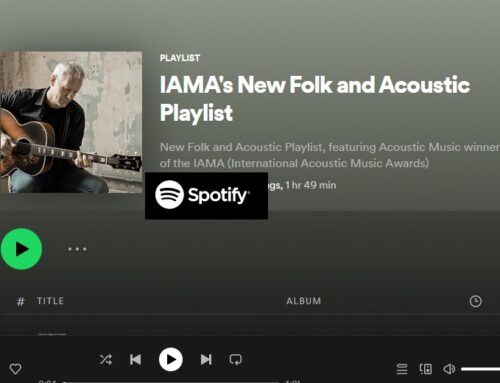10 Essentials for a Great Musician Website
by Allison Sharpe
As a professional musician, being good at making music isn’t enough. You also have to market, promote, manage gigs, and sometimes even drive the tour bus!
Because you wear so many hats, it’s best to find tools and resources to make it easier to manage everything. The best place to start is with your own custom website. This is the homebase for you and your music.
You might be tempted to forego a website and just use social media. This is a mistake. Although social media is a vital part of your marketing strategy, it doesn’t replace having a dedicated website for your music. Your website and social media work hand-in-hand to bring the most attention to your band.
There are many articles and courses on using social media, but in this post we’ll focus on your music website. Before you jump into building something it’s important to know the basics of what makes a successful music website. Use these ten tips as a guideline when you build your website and you’ll be good to go!
1. Five second rule
No this isn’t about dropping food on the ground, it’s about dropping knowledge of who you are to site visitors! In website design there’s a concept called the five second rule. If your visitor can’t figure out who you are and what you do in the first five seconds, they will most likely click off your page.
Right away your visitors should know your name, genre of music, and where you’re from. Your website is not the place to be vague and mysterious. Adding your genre and location is also great for search engine optimization (SEO).
2. Design
If your website is boring and outdated, people won’t want to stick around. You must have an eye-catching band website design to keep fans focused on you. Start by choosing a sleek modern style from a host of online band website templates.
Regardless of genre, you’ll want to stick to a design that’s organized and easy to navigate. From there you’ll tailor the website with colors and fonts that suit your style. Although your website starts as a blank canvas, it isn’t ideal to paint your website with multiple colors.
To achieve a professional look you’ll want to stick to 3-4 main colors. To choose these colors first think about your personality and the mood of your music. If your music is heavy you may want to go with darker colors. If your music is light and airy you may want to stick to pastels or earth tones. Choose your primary brand color then use an online color wheel like Abode Color CC to find complementary colors.
Typography (the text on your website) is also an important element to think about. With a huge selection of fonts out there it may be tempting to choose one with barbed wire, polka dots or curly Q’s. Resist this urge. Text on your website need to be easy to read, so stick to modern fonts with clean lines.
3. Have a mobile-friendly website
It’s no surprise that more people are viewing websites from mobile devices than from desktop computers. Because of this, your fans will want the browsing experience to be just as nice while they’re out and about. They should easily be able to comment on blog posts, listen to music, watch videos, and make purchases.
When choosing a website builder make sure the website is optimized for mobile. The website you build should work well on screens of all sizes. Another factor to consider is that mobile responsive websites rank higher in Google searches. In fact, Google punishes websites by ranking them lower if they don’t work well on mobile devices.
4. Professional photos
We’re in a visually stimulated society, so websites with poor images won’t fare well. You may be thinking, “I’m not worried, my phone takes amazing pictures!” but think again. Those images look great on your phone because they’re optimized for small screens. When you upload it to your website header area the image will be stretched and can appear blurry. This will make the website look like an ametuer built it and that’s not the vibe you’re going for.
I know it’s not fun, but it’s worth it to spend the extra money on a professional photographer. These photos will look great on your website as well as on social media, blog posts and in your electronic press kit.
5. Call-to-action
Do you want fans to buy your music? Ask them for the sale! Do you want them to watch your latest music video? Ask them to click the play button. This type of request on a website is known as a call-to-action (CTA).
It’s ok to have more than one CTA on the page, but you don’t want to add too many as this can overwhelm site visitors. Your best bet is to place one CTA over the header image and another one in the content area of your homepage. The goal of a CTA is to keeps visitors interested and engaged as they navigate your website and music.
6. Mailing list
Speaking of CTA’s, the most important one is the mailing list signup. You may be thinking, “Well I want to make money so my main CTA is for fans to buy my music!”
That’s a fine thought, but in reality this is short-term thinking. Instead of focusing on one sale, think of the long term goal – to make many sales.
When you get someone onto your mailing list you have access to tell them about everything you’re doing. This includes new music, tours, merch, and more. Staying in consistent contact keeps you connected to fans. This also makes them comfortable to buy from you over and over again.
7. Easy navigation
Getting fans to your website is half the battle. The other half is keeping them there. One way to do this is by making it fun to navigate. People are bogged down with information. Attention spans are short. Keep your website simple and your navigation menu to eight tabs or less. If you notice your menu growing, consider using sub-pages or condensing information.
Another great option is to give fans the option to play your music as they peruse your website. You don’t want to auto-start the music though. This can be annoying, especially when someone is visiting from a quiet location like their job. If the music starts blaring right away they’ll embarrassingly click off and most likely not come back. If someone came to your music site they want to hear your music. Let them decide when to click play.
8. EPK
If you want music professionals to know about you, you have to make it easy for them to find your information. In the past you could package up a press kit and send it through the post office. Since snail mail is pretty much dead (and unsolicited mail gets junked most of the time), it’s better to use an electronic press kit (EPK).
Thinking about building an EPK may seem intimidating but if you follow a blueprint it’s easy. In simplified terms an EPK is a summary of everything you have on all your other website pages. Instead of listing all your songs from your Music page, for example, you’d just add a couple to an EPK page. Instead of a photo gallery you’d upload a handful of hi-resolution images media reps can download.
The EPK page should be concise with just enough content to pique the curiosity of the page visitor to want more.
9. Music
The two types of fans that visit music websites are potential fans and existing fans. Potential fans are people who don’t know much about you yet. They may have heard about you from a friend or saw you as an opening act for another band. They want to know more about you so when they hit your website make sure they can hear your music.
You can do this by having a sitewide music player. This is a music player that sits at the bottom of your website and plays while visitors are navigating your pages.
Existing fans are supporters who know and love you already. When they come to your website they want to know what’s new with you. Make sure to put your best couple of songs on the homepage. Add new releases at the top of the page as well. With consistent uploads this will encourage fans to come back to your site to buy your music.
10. Update
After you build your website, don’t abandon it. Keep your website updated with new music, photos, events, and blog posts. Share the new content on social media but encourage your followers to visit your site for more.
When visitors come to your website you have their full attention. They won’t be distracted by ads, sponsored posts, political rants and cat videos as they are on social media. Instead they are there to learn about you and listen to your music. If they get to your website and there’s nothing new it will make them wonder if you’re still active as a band or musician.
Now you know the essentials of website design for bands and musicians. If you haven’t built a website yet, it’s easy to get started. You can learn more about building a professional music website here.
Allison Sharpe is the Education & Events Specialist at musician website & marketing platform Bandzoogle
For more information on the 15th Annual IAMA (International Acoustic Music Awards), go to: https://www.inacoustic.com




